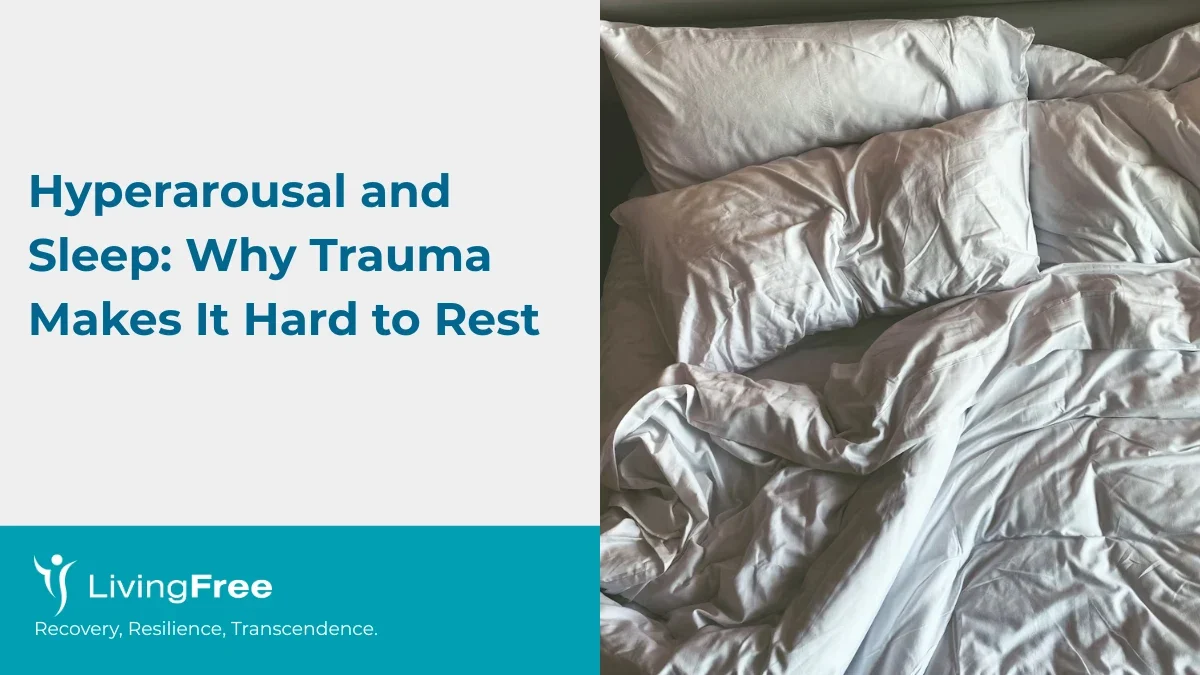Hyperarousal sleep happens when your body and brain stay alert even when you are tired.
It is a core part of insomnia, caused by an overactive central nervous system that struggles to switch off.
This constant alertness shows up as racing thoughts, muscle tension, and a feeling of being “on edge.”
The body stays in survival mode instead of letting go.
Experts call this pattern the hyperarousal model of insomnia.
It means the body is stuck in a state of wakefulness that can last through the night, and sometimes into the day.
How Hyperarousal Affects Sleep
Difficulty Falling and Staying Asleep
When the sympathetic nervous system stays active, the body cannot relax.
You may feel tired yet unable to fall asleep, or wake up often because your brain keeps scanning for danger.
Racing Thoughts and Nighttime Anxiety
At bedtime, thoughts can speed up instead of slowing down.
You might replay your day, plan tomorrow, or worry about not sleeping.
This mental tension blocks the brain’s ability to drift into deep sleep.
Physical Tension
Hyperarousal is also physical.
Your heart may beat faster, breathing stays shallow, and the body feels hot or restless.
Studies show that people with insomnia have higher brain-wave activity and stress-hormone levels even while lying still.
Daytime Fatigue
Hyperarousal does not end with morning light.
It can carry through the day, leaving you exhausted but wired.
You may notice poor focus, irritability, or a sense that you can never truly relax.
What Causes Hyperarousal
Stress and Emotional Overload
Stress hormones like cortisol and adrenaline keep the body alert.
When they stay high for too long — because of work, trauma, or worry — the body forgets how to rest.
Genetics
Some people are naturally more sensitive to stress and sleep loss.
A family history of insomnia can increase the chance of developing hyperarousal.
Learned Response
If sleepless nights happen often, the brain can learn that the bed means “stay awake.”
Just lying down can make the body tense, creating a loop of anxiety and alertness.
Daily Habits
Late caffeine, screen time in bed, irregular hours, or using alcohol to unwind all feed the cycle.
They trick the brain into staying awake and prevent natural drowsiness.
The Hyperarousal Theory of Insomnia
Researchers describe insomnia as a problem of constant activation rather than just poor sleep.
In this theory, the stress system never turns off.
The autonomic nervous system and the HPA axis keep producing alertness signals.
Brain scans show that people with chronic insomnia have higher activity in areas that should rest at night.
Their bodies are awake when they should be asleep.
How to Treat and Manage Hyperarousal Insomnia
1. Calm the Stress Response
Start with gentle ways to quiet the body.
Try slow breathing, mindfulness, or progressive muscle relaxation.
The 4-7-8 or physiological sigh methods slow your heart rate and help activate the “rest and digest” system.
2. Practice Good Sleep Hygiene
Keep a regular sleep and wake schedule.
Make your room dark, quiet, and cool.
Avoid caffeine, nicotine, and screens for at least an hour before bed.
Consistency teaches the body when it is safe to sleep.
3. Use Grounding Techniques
If your mind races, focus on your senses.
Notice what you feel, hear, or smell.
You can try the 5-4-3-2-1 grounding method to anchor yourself in the present moment.
4. Try Cognitive Behavioral Therapy for Insomnia (CBT-I)
CBT-I is an evidence-based therapy that helps you change the thoughts and habits that keep insomnia going.
It replaces sleep anxiety with confidence and helps rebuild a calm association with bedtime.
5. Adjust Daily Lifestyle
Gentle exercise, morning sunlight, and time in nature lower overall arousal.
Avoid alcohol as a sleep aid — it may make you sleepy but disrupts deep sleep later in the night.
6. Get Professional Support
If sleeplessness lasts more than a few weeks, talk with a doctor or sleep specialist.
They can help uncover deeper causes and discuss treatments such as CBT-I, relaxation training, or short-term medication.
Trauma-informed therapies like Somatic Experiencing or Polyvagal Therapy can also help your body feel safe enough to rest.
Why You Might Wake Up After Five Hours of Sleep
Many people with hyperarousal insomnia wake up around the same time each night.
As sleep becomes lighter, the body senses relaxation as unsafe and switches back into alert mode.
Building consistent routines and using grounding or breathing before bed can extend deep sleep cycles over time.
Common Signs of Hyperarousal Insomnia
Trouble falling asleep or staying asleep
- Racing thoughts or restlessness at night
- Muscle tension or a fast heartbeat in bed
- Feeling tired but unable to relax
- Early morning awakenings with worry
- Daytime fatigue, poor focus, or irritability
If these signs continue for weeks, the body may be stuck in a state of chronic hyperarousal.
Relearning How to Rest
Healing from hyperarousal sleep is not about forcing sleep to happen.
It is about teaching your body that rest is safe again.
Each calm breath, each quiet routine, tells your nervous system it no longer needs to stay on guard.
With patience and consistency, real rest will return, naturally.
Related Reading
- Chronic Hyperarousal: When Stress Becomes a Way of Life
- How to Calm a Hyperaroused Nervous System
- What Causes Hyperarousal? Understanding the Body’s Alarm System
- Signs and Symptoms of Hyperarousal You Shouldn’t Ignore
- Are You Experiencing Hyperarousal?
- Re-Experiencing, Emotional Numbing, and Hyperarousal in PTSD
- Avoidance in PTSD: Understanding the Hidden Coping Mechanism


